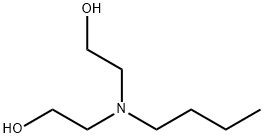- N-Butyldiethanolamine
-

- $100.00 / 1kg
-
2024-04-24
- CAS:102-79-4
- Min. Order: 1kg
- Purity: 99.93%
- Supply Ability: 1000kg per week
|
| | 2,2'-(Butylimino)diethanol Basic information |
| Product Name: | 2,2'-(Butylimino)diethanol | | Synonyms: | Ethanol, 2,2-(butylimino)bis-;Butyldiethanolamin;N-N-BUTYL-2,2'-IMINODIETHANOL;N-N-BUTYLDIETHANOLAMINE;N,N-BIS(2-HYDROXYETHYL)BUTYLAMINE;N-BUTYLBIS(2-HYDROXYETHYL)-AMINE;N-BUTYL-2,2'-IMINODIETHANOL;TIMTEC-BB SBB008846 | | CAS: | 102-79-4 | | MF: | C8H19NO2 | | MW: | 161.24 | | EINECS: | 203-055-0 | | Product Categories: | | | Mol File: | 102-79-4.mol |  |
| | 2,2'-(Butylimino)diethanol Chemical Properties |
| Melting point | ?70 °C (lit.) | | Boiling point | 273-275 °C/741 mmHg (lit.) | | density | 0.986 g/mL at 25 °C (lit.) | | vapor density | 5.5 (vs air) | | vapor pressure | 1 mm Hg ( 25 °C) | | refractive index | n20/D 1.463(lit.) | | Fp | 260 °F | | storage temp. | Store below +30°C. | | form | Powder | | pka | 14.41±0.10(Predicted) | | Specific Gravity | 0.970 (20/4℃) | | color | Red-brown to dark brown | | PH | 10.8-11.1 (100g/l, H2O, 20℃) | | explosive limit | 1.1-6.5%(V) | | Water Solubility | miscible | | Sensitive | Hygroscopic | | BRN | 1739642 | | Stability: | Stable. Combustible. Incompatible with strong oxidizing agents. | | InChIKey | GVNHOISKXMSMPX-UHFFFAOYSA-N | | LogP | 0.58 at 25℃ | | CAS DataBase Reference | 102-79-4(CAS DataBase Reference) | | NIST Chemistry Reference | Ethanol, 2,2'-(butylimino)bis-(102-79-4) | | EPA Substance Registry System | Ethanol, 2,2'-(butylimino)bis- (102-79-4) |
| Hazard Codes | C | | Risk Statements | 34-37 | | Safety Statements | 26-36/37/39-45 | | RIDADR | UN 2735 8/PG 2 | | WGK Germany | 1 | | RTECS | KK0525000 | | Autoignition Temperature | 260 °C | | TSCA | Yes | | HazardClass | 8 | | PackingGroup | II | | HS Code | 29221980 | | Toxicity | LD50 orally in Rabbit: 4800 mg/kg |
| | 2,2'-(Butylimino)diethanol Usage And Synthesis |
| Chemical Properties | colourless to light yellow liquid | | Uses | N-Butyldiethanolamine (H2bdea, N-n-butyldiethanolamine) has been used in the synthesis of the following complexes (Hdnba = 3,5-dinitrobenzoic acid, Hpta = p-toluic acid, H2tpa = terephthalic acid):
- new mononuclear [Cu(Hbdea)2]·2Hdnba , dinuclear [Cu2(μ-Hbdea)2(N3)2] and [Cu2(μ-Hbdea)2(pta)2]·2H2O
- 1D polymeric [Cu2(μ-Hbdea)2(μ-tpa)]n·2nH2O copper(II) compounds
- tetranuclear 3d-4f single-molecule magnet (SMM) complexes
| | General Description | N-Butyldiethanolamine (N-n-butyldiethanolamine) is a tertiary amine. It acts as an N-substituted diethanolamine ligand. It reacts with chromium(II) and lanthanide(III)/rare earth salts (Ln = La, Ce, Pr, Nd, Sm, Eu, Gd, Tb, Dy, Ho, Er, Tm, Yb, Lu, Y) in the presence of coligands to afford three series of isostructural 1:1 3d(Cr(III))/4f(Ln(III)) coordination cluster compounds. | | Flammability and Explosibility | Non flammable | | Safety Profile | Mddly toxic via
ingestion. A skin and severe eye irritant.
Combustible when exposed to heat or
flame. To fight fire, use alcohol foam, foam,
CO2, dry chemical. Incompatible with
oxidizing materials. When heated to
decomposition it emits toxic fumes of NOx.
See also AMINES. | | Toxics Screening Level | The initial threshold screening level (ITSL) for Butyldiethanolamine is 14 μg/m3 annual avg based on this LD-50 using the equation in R232(1)(h). |
| | 2,2'-(Butylimino)diethanol Preparation Products And Raw materials |
|